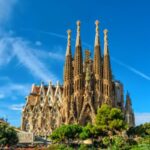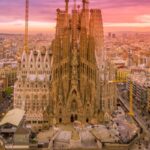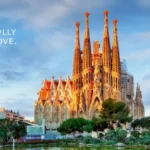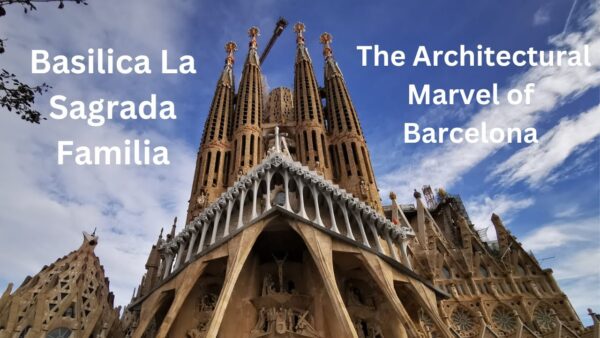
- The History Behind the Sagrada Familia: A Journey Through Time
- Architectural Features of the Sagrada Familia: Gaudí's Genius Unveiled
- The Cultural Significance of the Sagrada Familia in Barcelona's Identity
- Visiting the Sagrada Familia: Tips and Insights for Tourists
- The Construction Process of the Sagrada Familia: An Ongoing Masterpiece
- Sagrada Familia: A Symbol of Faith and Art in Modern Architecture
The Sagrada Familia, designed by the visionary architect Antoni Gaudí, stands as an unparalleled testament to modernist architecture. With its intricate facades and towering spires, this iconic basilica captures the imagination of millions of visitors each year, drawing them into a world of artistic ingenuity and spiritual reflection.
Recognized globally for its unique design and cultural significance, The Architectural Marvel: Sagrada Familia in Barcelona continues to inspire awe and admiration. As construction progresses, this masterpiece symbolizes both Gaudí's creative genius and the enduring spirit of a city that embraces its rich artistic heritage.
The History Behind the Sagrada Familia: A Journey Through Time
The history of the Sagrada Familia is a fascinating saga that begins in 1882, when the first stone was laid. Initially conceived as a traditional church, the project took a dramatic turn under Antoni Gaudí's leadership, who took over the design in 1883. His vision transformed it into a monumental basilica, integrating elements of nature and religion into its architectural form.
Over the years, the construction faced numerous challenges, including funding shortages and the Spanish Civil War, which halted progress from 1936 to 1952. Despite these setbacks, the project continued to evolve, guided by the principles laid out by Gaudí. Today, more than a century later, the Sagrada Familia stands as a symbol of perseverance and artistic ambition.
- 1882: The foundation stone is laid.
- 1883: Antoni Gaudí takes charge of the project.
- 1936-1952: Construction halted due to the Spanish Civil War.
- 2026: Anticipated completion date for the basilica.
As the Sagrada Familia nears its completion, it merges the past and present, showcasing innovative techniques and materials that honor Gaudí's original vision. This journey through time not only celebrates architectural ingenuity but also reflects Barcelona's commitment to maintaining its rich cultural tapestry.
Architectural Features of the Sagrada Familia: Gaudí's Genius Unveiled
The Sagrada Familia showcases an array of extraordinary architectural features that exemplify Gaudí's innovative approach. One of the most striking elements is its intricate facades, each telling a different story through elaborate sculptures and carvings. The Nativity Facade, replete with organic motifs and biblical scenes, contrasts sharply with the Passion Facade's stark, angular lines, symbolizing the duality of life and death.
Another remarkable aspect is the use of hyperboloid structures in the design of the columns and vaults. These structures not only provide strength but also create an ethereal quality within the interior space. The tree-like columns that branch out at the top mimic a forest canopy, allowing natural light to filter in, enhancing the spiritual experience of visitors.
The basilica’s spires, reaching heights of up to 170 meters, are also a testament to Gaudí's vision. Each of the spires is dedicated to a different religious figure, with the tallest representing Jesus Christ. This verticality is not just for aesthetic appeal; it reflects the architect's desire to create a connection between heaven and earth.
| Architectural Feature | Description |
|---|---|
| Facades | Intricate designs representing different themes, such as life, death, and resurrection. |
| Columns | Tree-like hyperboloid structures that support the roof while creating a natural atmosphere. |
| Spires | Statuesque towers dedicated to various religious figures, symbolizing faith and spirituality. |
Overall, the architectural features of the Sagrada Familia not only exhibit Gaudí's unique genius but also reflect a profound spiritual significance, making this basilica a landmark of both artistic achievement and a pilgrimage site for many.
The Cultural Significance of the Sagrada Familia in Barcelona's Identity
The Sagrada Familia serves as a profound emblem of Barcelona's cultural identity, embodying the city's rich history and artistic innovation. This architectural masterpiece transcends mere construction; it represents the collective aspirations and resilience of Barcelonians striving to create a lasting legacy. The basilica’s intricate design and ongoing construction reflect the city's dedication to art and tradition, reinforcing its status as a global cultural hub.
Moreover, the Sagrada Familia plays a vital role in shaping Barcelona's tourism and economy. It attracts millions of visitors annually, contributing significantly to local businesses and the overall cultural landscape. The basilica not only enhances the city's skyline but also serves as a focal point for cultural events and gatherings, further embedding itself in the social fabric of Barcelona.
- Tourism Impact: Attracts over 4.5 million visitors each year.
- Cultural Events: Hosts religious ceremonies, concerts, and art exhibitions.
- Economic Contribution: Generates substantial revenue for local businesses.
Additionally, the Sagrada Familia's ongoing construction embodies a unique blend of tradition and modernity. Each phase of its development incorporates contemporary techniques while honoring Gaudí's original vision. This fusion of past and present not only showcases Barcelona's architectural evolution but also signifies the city's commitment to preserving its cultural heritage for future generations.
Visiting the Sagrada Familia: Tips and Insights for Tourists
When planning your visit to the Sagrada Familia, it’s essential to consider the best times to go. Early mornings or late afternoons are generally less crowded, allowing for a more serene experience. Additionally, purchasing your tickets online in advance can save you time and guarantee your entry, especially during peak tourist seasons. Be sure to check the weather forecast, as natural light plays a vital role in showcasing the basilica's stunning interiors.
As you explore the Sagrada Familia, take your time to appreciate the smallest details. Each facade and interior element is a masterpiece in its own right. Consider joining a guided tour to gain deeper insights into Gaudí’s vision and the biblical stories depicted throughout the basilica. This will enrich your understanding and appreciation of this architectural marvel, making your visit truly memorable.
- Best Visit Times: Early mornings or late afternoons for fewer crowds.
- Tickets: Purchase online in advance to avoid waiting in line.
- Guided Tours: Highly recommended for a more comprehensive experience.
Don't forget to bring your camera! The Sagrada Familia offers countless photo opportunities, from the intricate carvings to the vibrant stained glass windows. Finally, allocate some time to relax in the surrounding park area. It provides a perfect vantage point to appreciate the basilica’s grandeur and capture its beauty in your photographs.
The Construction Process of the Sagrada Familia: An Ongoing Masterpiece
The construction process of the Sagrada Familia is a remarkable journey that intertwines tradition and innovation. Initiated in 1882, this architectural wonder has evolved over more than a century, adapting to modern technologies while remaining true to Antoni Gaudí's original vision. The ongoing work reflects a commitment to preserving the intricate details and artistic expression that define this basilica, ensuring that every element contributes to its grandeur.
One of the most significant aspects of the construction process is the incorporation of advanced techniques and materials. Modern tools such as 3D modeling and computer-aided design have dramatically enhanced the precision of the work. These innovations allow builders to recreate Gaudí's complex designs with accuracy, bridging the gap between the past and present. Each stage of construction is meticulously planned to maintain the integrity of the original concept.
Throughout its history, the Sagrada Familia has faced various challenges, including funding and political turmoil. Despite these obstacles, the project has persevered, largely due to the dedication of craftsmen and architects who continue to uphold Gaudí's legacy. The anticipated completion date of 2026 coincides with the centenary of Gaudí's death, symbolizing a full-circle moment for this architectural masterpiece.
As the basilica nears its completion, the significance of its construction process becomes ever more apparent. It not only showcases a unique blend of artistic ambition and engineering prowess but also serves as a testament to the enduring spirit of collaboration. Each brick laid is a tribute to the generations of builders who have contributed to this ongoing masterpiece, creating a structure that resonates with both spiritual meaning and cultural significance.
Sagrada Familia: A Symbol of Faith and Art in Modern Architecture
The Sagrada Familia is not just an architectural feat; it stands as a symbol of faith and artistic expression within modern architecture. Its towering spires and intricate details convey a deep reverence for spirituality, intertwining elements of nature and religion. This unique approach allows visitors to experience a profound connection to the sacred while marveling at Gaudí’s innovative design, making the basilica a significant landmark for both worship and artistic appreciation.
Moreover, Sagrada Familia serves as a bridge between the past and the future, symbolizing the ongoing evolution of architectural practices. The basilica’s construction incorporates a blend of traditional craftsmanship and contemporary technologies, demonstrating how modern architecture can honor historical styles. Key features that highlight this synthesis include:
- Use of Sustainable Materials: Incorporating eco-friendly resources to align with today's architectural sustainability goals.
- Advanced Techniques: Employing innovative building methods, such as 3D modeling, to ensure precision in the replication of Gaudí's vision.
- Artistic Collaborations: Involvement of diverse artisans who contribute their skills to enhance the basilica’s intricate details.
As a result of its unique blend of artistry and spirituality, the Sagrada Familia has become an essential pilgrimage site for many. It encapsulates the essence of Barcelona's identity, representing a city that cherishes its cultural heritage while embracing the future. With every completed section of the basilica, the spirit of community and collective aspiration continues to flourish, making the Sagrada Familia a true marvel of modern architecture.
In conclusion, the Sagrada Familia stands as a beacon of hope and creativity, a testament to what humanity can achieve when faith and art converge. Its towering presence not only defines the Barcelona skyline but also invites contemplation and admiration from all who visit. This architectural masterpiece embodies a timeless journey of faith, resilience, and artistic brilliance that resonates deeply with people from all walks of life.
 Follow Carrer de Montcada to Plaça del Fossar de les Moreres
Follow Carrer de Montcada to Plaça del Fossar de les Moreres Visit the Famous Sagrada Familia in Barcelona
Visit the Famous Sagrada Familia in Barcelona Discover the Marvelous Sagrada Familia: A Must-Visit in Barcelona!
Discover the Marvelous Sagrada Familia: A Must-Visit in Barcelona! Exploring the Majestic Sagrada Familia: Barcelona's Official Website
Exploring the Majestic Sagrada Familia: Barcelona's Official WebsiteIf you want to know other articles similar to The Architectural Marvel: Sagrada Familia in Barcelona you can visit the category WHERE YOU CAN GO.
Deja una respuesta










Read more!